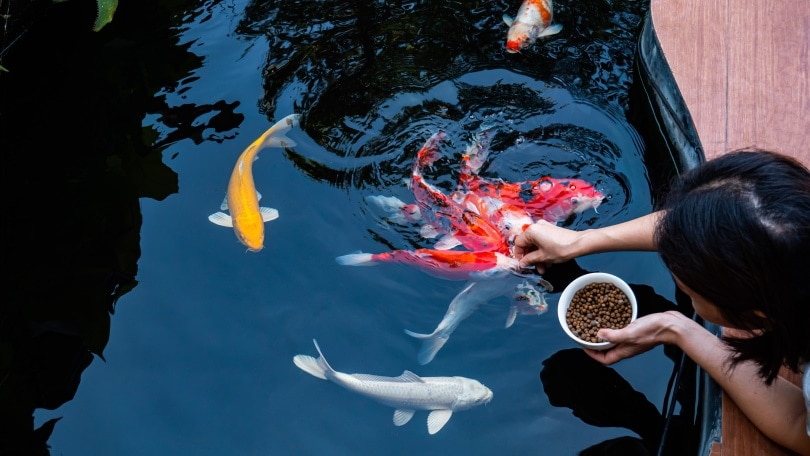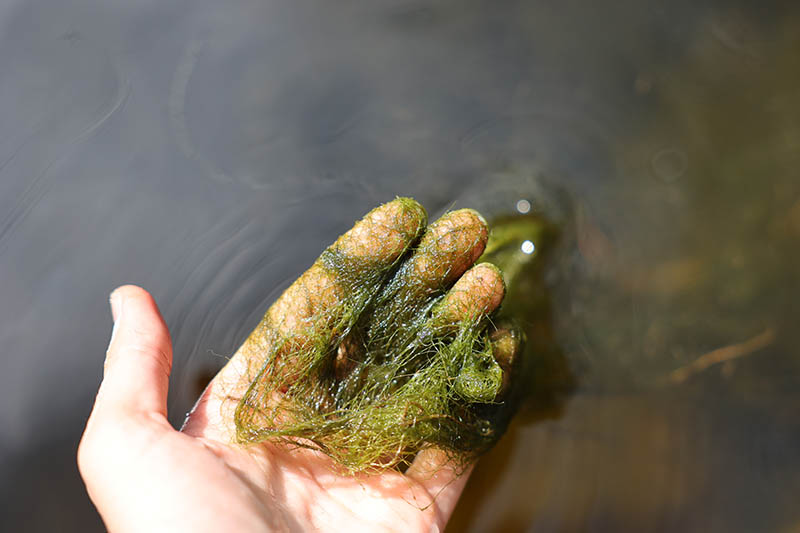While algae is essential to a healthy pond, too much of it can make your pond look unattractive, it can rob your pond of oxygen, and possibly endanger your aquatic life.
Many goldfish and koi pond owners have a problem with string algae during the summertime. This type of algae, which is also known as filamentous algae, looks like long strands of slimy green hair and it attaches itself to plants, forms on the side of ponds, and hangs on the surface of the water. The algae’s long strands tangle up and form thick mats that can quickly get heavier and heavier if it’s not controlled.
If your pond is plagued by string algae, you may have an unsightly mess that you don’t know what to do with. However, you don’t have to worry about the health of your fish as this type of algae isn’t dangerous. The key to getting rid of filamentous algae is to reduce the nutrients that fuel the algae’s growth cycle.

What Causes String Algae?

String algae is typically caused by one or more of the following reasons:

The 3 Ways to Get Rid of String Algae
It’s not terribly difficult to rid a pond of string algae, but you must be prepared to do some work and get your hands dirty. Here are three steps to take to help you solve the problem so your backyard pond will be more enjoyable to look at.
1. Introduce Some Fast-Growing Plants
The main cause of an overabundance of string algae is an overabundance of the nutrients this slimy green algae feeds on. One way to reduce these nutrients is to add plants to your pond that use the same nutrients as string algae. The plants you introduce should either reproduce rapidly or grow larger.
Water lettuce is a good plant to add to your pond as it grows very quickly and uses the same nutrients as string algae. If you add water lettuce, you’ll have to prevent it from overtaking your pond by pulling some of it out now and then and throwing it away. This way, you can prevent the water lettuce from getting out of hand and allow more to grow in so it can use up the nutrients.
If you’re not crazy about the idea of constantly removing water lettuce, you can try marginal and bog plants like irises and cattails. Both of these plants require less upkeep and they are very good at dealing with early algae blooms that typically occur during the spring months.

2. Do Some Old-Fashioned Weeding
Weeding algae from your pond is a bit wetter than pulling weeds from your vegetable garden but it’s a good way to get rid of string algae. It’s a quicker way to weed too as all you need to do is grab handfuls of string algae by the base and pull them up. Then simply toss the algae strands in a bucket and dispose of them. While this can be a messy & physical job, it’s an effective way to get rid of the unsightly algae that’s taken up residence in your backyard pond.
3. Feed Your Fish Less Often
Koi and goldfish love nibbling and especially when they’re not being overfed. By feeding your fish less often, you’ll be surprised by how well they can mow down the string algae in your pond. When you feed your fish less often, it will also decrease the nutrients string algae lives on, so it’s like killing two birds with one stone. A sign you’ve been feeding your fish too much is seeing uneaten food leftover in the water after feeding time.

Why You Shouldn’t Use an Algaecide
Even though it may seem like a logical idea to use an algaecide to get rid of string algae, it’s not. While it’s fine to use a copper-based algaecide to battle small amounts of visible algae from time to time, this type of product needs to be used with extreme care.
When an algaecide is used too often, it can kill algae too quickly which would bring about even more pond problems including a lack of oxygen and a toxic reaction for the fish and other plants living in the pond.
Many algicides also can deplete a pond of good bacteria that works to keep the pond clean. When these bacteria are absent from the water, algae can develop easier and it can put you in a never-ending cycle of pouring chemicals into your pond. While an algaecide may work to control the algae you can see, it does nothing to remedy the bigger problem of string algae taking over your pond.

Conclusion
While string algae is not harmful to the fish in your pond, it is a nuisance to water quality and the aesthetics of your backyard pond. If you have a string algae problem, it’s best to address it right away before the algae grows out of control and overtakes your pond. Even though solving a string algae problem takes time and effort, it can be brought under control by taking the steps above.
Read More:
Featured Image Credit: Dominique F Snyder, Shutterstock

